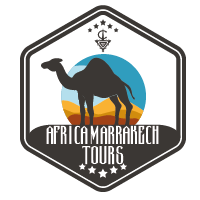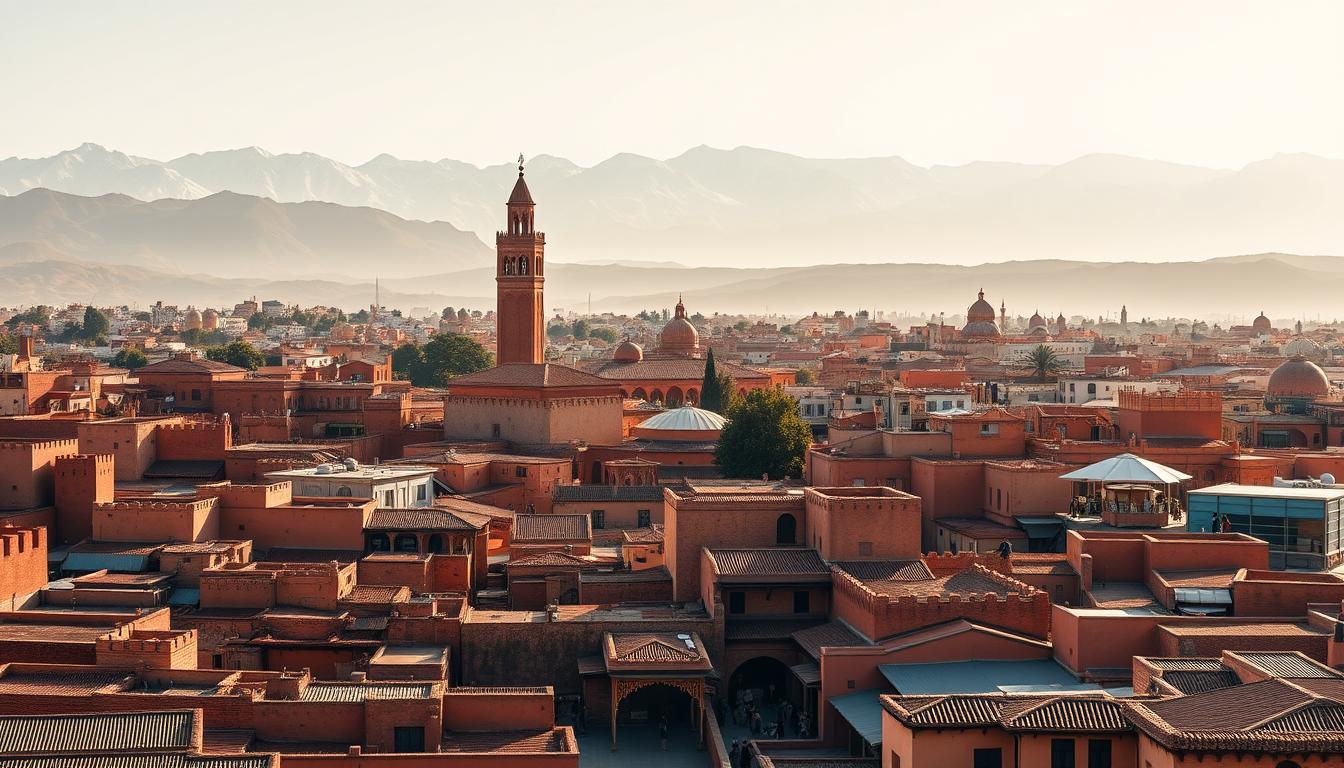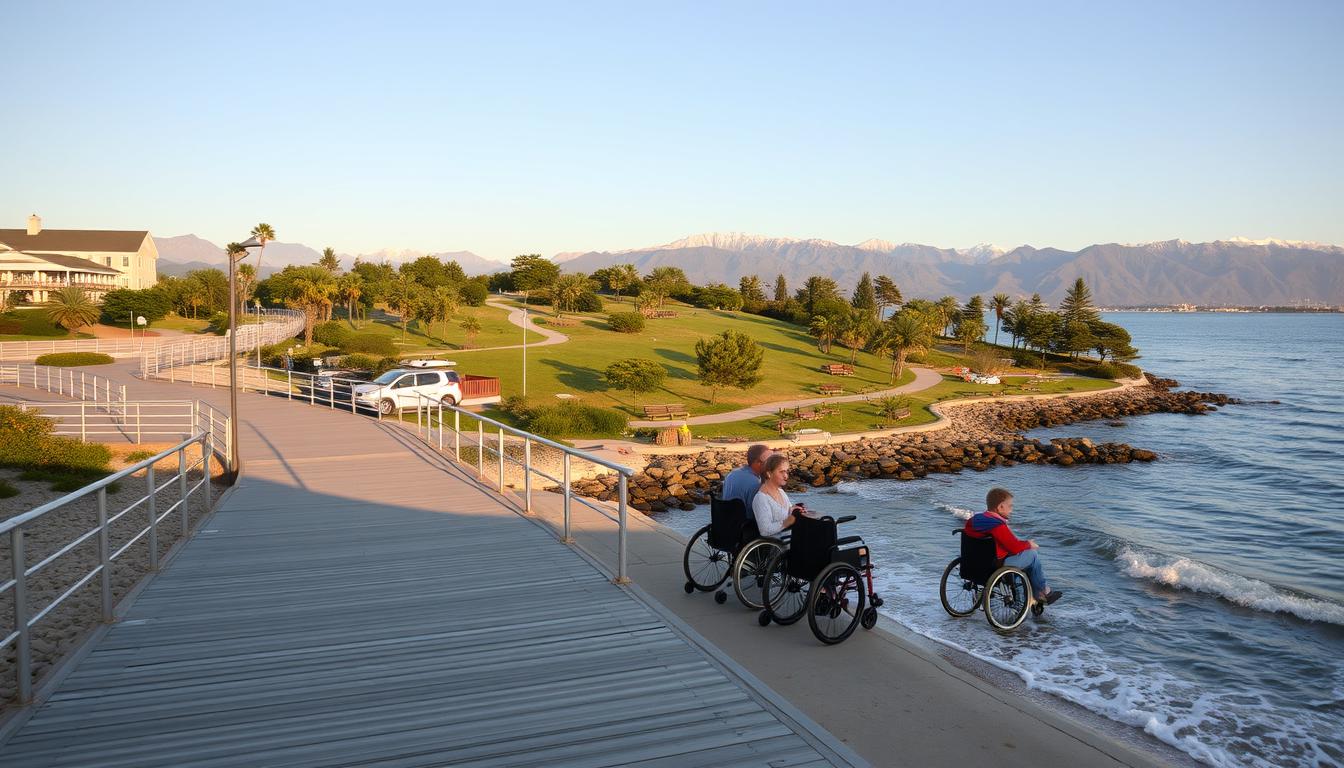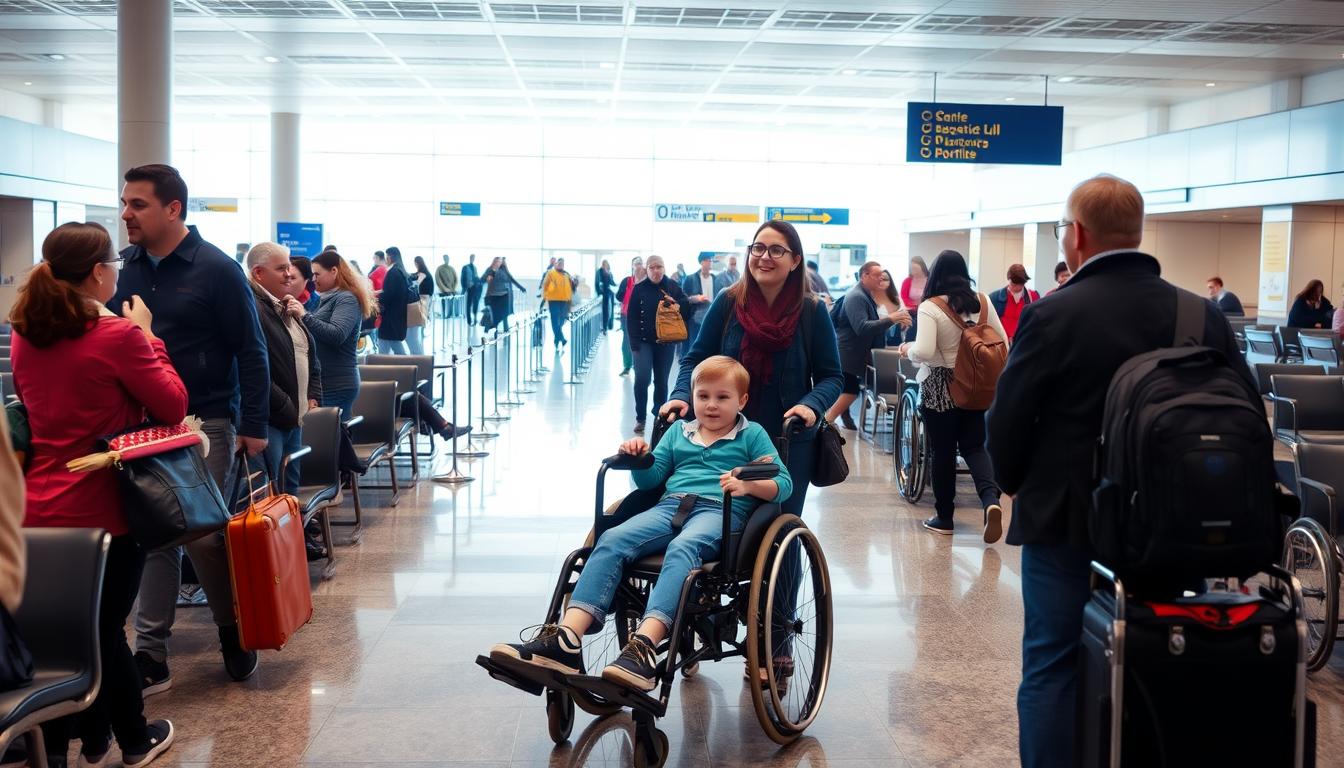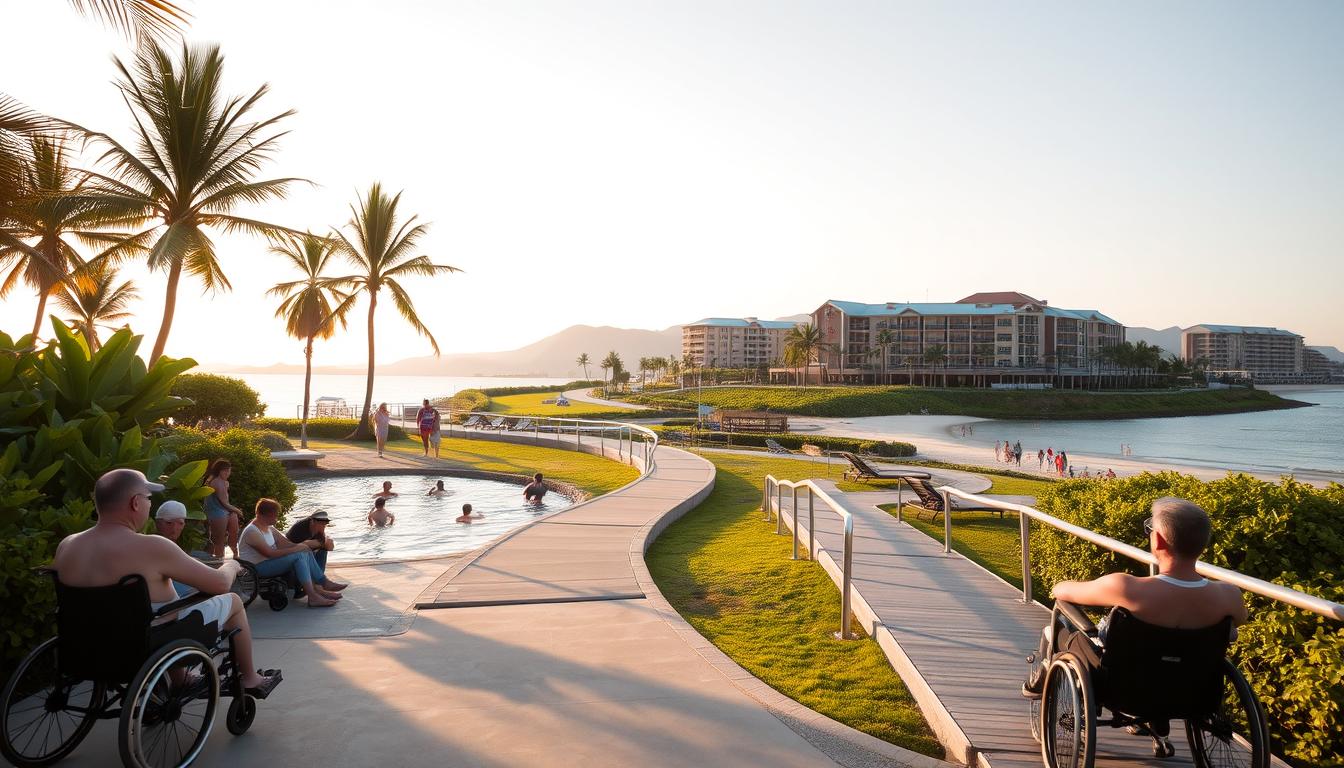Imagine walking through ancient medinas, vibrant markets, and historic landmarks. Morocco’s Imperial Cities offer a journey through the country’s rich history and culture. It’s a treasure trove waiting to be explored.
As you embark on this adventure, you’ll discover the unique charm of each city. From the bustling streets of Marrakech to the serene beauty of Fez. With an imperial cities tour morocco, you can experience the best of Morocco’s heritage.
Key Takeaways
- Explore the historic medinas and landmarks of Morocco’s Imperial Cities.
- Experience the vibrant culture and rich history of Marrakech, Fez, and other cities.
- Discover the unique charm of each city on a guided tour.
- Enjoy the local cuisine and hospitality that Morocco is known for.
- Create unforgettable memories on your Morocco Imperial Cities itinerary.
Introduction to Morocco’s Imperial Cities
Exploring Morocco’s Imperial Cities reveals the country’s rich history and culture. These cities are key to Morocco’s past, each with its own story and architectural style. They make up the country’s rich heritage.
What Are Imperial Cities?
Morocco’s Imperial Cities were once the capitals of various dynasties. They are called ‘imperial’ because of their grand architecture and vibrant culture. These cities have a deep history.
Historical Significance
The historical importance of these cities is immense. They were centers of power, culture, and learning for centuries. Scholars, artists, and leaders have walked their streets.
Visiting these cities lets you see the mix of Arab, Berber, and French influences on Moroccan culture. You can wander ancient medinas, see architectural marvels, and taste the local cuisine. It’s a delicious mix of diverse heritage.
Overview of Key Cities
Morocco’s Imperial Cities are Marrakech, Fes, Meknes, and Rabat. Each offers a unique experience. You can take a guided tour to learn more about their history and culture.
- Marrakech is famous for its lively souks and beautiful architecture.
- Fes is known for its ancient medina and historical importance.
- Meknes shows Morocco’s imperial past with its grand buildings.
- Rabat, the capital, mixes modern and traditional attractions.
Together, these cities are the heart of Morocco’s culture and history. They are essential for anyone wanting to explore Morocco’s rich heritage.
Marrakech: The Red City
Marrakech is a city that mixes old traditions with new styles. It’s a key place to see in Morocco’s imperial cities. Walking through its lively streets, you’ll find a place where history and culture are alive.
Must-See Attractions
Marrakech has many famous landmarks that show its rich history. The Jardin Majorelle is a beautiful botanical garden made by French artist Jacques Majorelle. Also, don’t miss the Koutoubia Mosque, the biggest mosque in Marrakech, known for its amazing architecture.
Don’t forget to see the Bahia Palace, a work of Islamic art, and the Jemaa el-Fnaa. This square is full of life at night.
| Attraction | Description | Best Time to Visit |
|---|---|---|
| Jardin Majorelle | Botanical garden with exotic plants and art galleries | Morning |
| Koutoubia Mosque | Historic mosque with impressive minaret | Afternoon |
| Bahia Palace | Example of Islamic craftsmanship and architecture | Anytime |
| Jemaa el-Fnaa | Vibrant square with street performers and food stalls | Evening |
Cultural Experiences
Marrakech has many cultural experiences. You can visit local workshops to see artisans making traditional goods. The souks, or markets, are also great places to find unique items like spices and jewelry.
Trying a cooking class is another way to dive into Marrakech’s culture. You’ll learn to make dishes like tagine and couscous with fresh local ingredients.
Local Cuisine
Marrakech is famous for its tasty food, showing the city’s diverse culture. Make sure to try tagine, a slow-cooked stew. Other must-try dishes are couscous and pastilla, a savory pie.
For a real taste of Marrakech, eat at a local riad. Riads are traditional Moroccan houses with beautiful gardens. They often offer cooking classes and delicious meals, showing off Marrakech’s rich food heritage.
Fes: The Spiritual Heart of Morocco
Fes is Morocco’s spiritual heart, calling to those who want to see its ancient traditions and vibrant souks. It’s a key stop for anyone on a luxury tour of morocco’s imperial cities. Here, you can dive deep into Morocco’s rich cultural heritage.
Exploring Fes El-Bali
Fes El-Bali is the ancient medina of Fes, one of the biggest and most preserved medieval cities worldwide. Walking its narrow streets, you’ll find historical landmarks, bustling markets, and cultural experiences. Don’t miss the Al-Attarine Madrasa, a stunning example of Islamic architecture.
For a full experience, take a guided tour from Marrakech to Fes. You can book this through Africa Tours Marrakech. It will help you understand Fes El-Bali’s history and culture better.
Artisan Workshops and Souks
Fes is famous for its artisan workshops, where skilled craftsmen keep traditional practices alive. Visiting these workshops gives you a peek into the city’s artisanal heritage. The souks, or markets, are also a highlight, filled with local goods like jewelry and textiles.
- Explore the souks for authentic local products.
- Visit artisan workshops to witness traditional craftsmanship.
- Engage with local artisans to learn about their techniques and traditions.
Important Historical Sites
Fes boasts many historical sites, showing its status as a spiritual and cultural center. The Al-Qarawiyyin Mosque, founded in 859 AD, is one of the oldest universities and a key religious site. The Dar Batha Museum also showcases Fes’s cultural heritage through its artifacts and crafts.
These sites, along with Fes’s lively culture, make it a must-see on any luxury tour of morocco’s imperial cities. Whether you’re wandering the ancient medina, visiting workshops, or enjoying the souks, Fes offers an unforgettable journey.
Rabat: Capital of Morocco
Rabat, Morocco’s vibrant capital, is a city where ancient history meets modern life. It’s a key stop on the historic Moroccan Imperial Cities tour. Here, you’ll find a unique mix of experiences that highlight its importance.
Key Landmarks to Visit
Rabat boasts many historical landmarks that show its rich past. The Kasbah of the Udayas is a must-see, with its amazing views of the Atlantic Ocean and well-preserved architecture. The Hassan Tower, an unfinished minaret, is a symbol of Rabat’s history and faith.
Don’t miss the Rabat Archaeological Museum. It has artifacts that tell Morocco’s story from ancient times to the Islamic era.
Modern vs. Traditional Rabat
Rabat perfectly mixes old and new. Its medina (old city) is a labyrinth of narrow streets with traditional souks and historic buildings. On the other hand, areas like Agdal and Les Orangers offer a modern vibe with luxury and modern architecture.
Cultural Highlights
Rabat is a cultural hotspot, hosting many festivals and events all year. The Mawazine Festival is a highlight, celebrating Moroccan and international music. The city’s museums, like the National Museum of Archaeology and Anthropology, also showcase Morocco’s rich cultural heritage.
Exploring Rabat, you’ll see its cultural wealth isn’t just in landmarks. It’s also in its lively daily life, from traditional crafts to modern art.
Meknes: The Hidden Gem
Meknes is a hidden treasure among Morocco’s Imperial Cities. It’s a place full of history and culture. On an imperial cities Morocco group tour, you’ll see its unique charm. The city mixes ancient architecture, lively markets, and deep history.
Architectural Marvels
Meknes is home to some of Morocco’s most stunning buildings. The Bab Mansour gate is a standout, one of the biggest and most decorated in the country. The historic medina, a UNESCO World Heritage site, showcases Islamic architecture beautifully.
Historical Significance
Meknes was founded in the 11th century and was Morocco’s capital under Sultan Moulay Ismail in the 17th century. Its history is seen in its monuments, museums, and sites like the Mausoleum of Moulay Ismail. It shows the city’s key role in the Alaouite dynasty.
Local Markets and Culture
Exploring Meknes lets you dive into local culture through its markets. The souks are alive with artisans selling unique crafts. You can also try the local food, a mix of Berber, Arab, and Mediterranean tastes.
| Aspect | Description | Highlight |
|---|---|---|
| Architecture | Blend of Islamic and Moroccan styles | Bab Mansour gate |
| History | Founded in the 11th century, capital in the 17th century | Mausoleum of Moulay Ismail |
| Culture | Vibrant markets and local cuisine | Traditional handicrafts and local dishes |
Exploring Meknes, you’ll see it’s a city that seamlessly weaves together its historical past with the vibrancy of modern Moroccan culture. It’s a key stop on any imperial cities Morocco group tour.
Tangier: Gateway to Africa
Tangier is a must-see on any Morocco trip. It’s known for its stunning beauty and rich history. Here, you’ll find a mix of cultures that have made the city what it is today.
Scenic Views and Beaches
The views in Tangier are amazing. The city’s coast along the Strait of Gibraltar is breathtaking, best seen at sunset. You can find great spots to watch the view, like the Corniche.
The beaches, like Plage de la Corniche and Plage Achakkar, are perfect for unwinding. Some are busy with tourists, while others are quiet and peaceful.
| Beach Name | Location | Facilities |
|---|---|---|
| Plage de la Corniche | Corniche Tangier | Restaurants, Restrooms, Lounges |
| Plage Achakkar | Achakkar, near Tangier | Camping Sites, Basic Amenities |
Historical Background
Tangier’s history is fascinating. It has been influenced by the Phoenicians, Romans, and Europeans. Its strategic location made it valuable to many empires. You can learn about this through landmarks like the Kasbah and the American Legation Museum.
The Kasbah shows off the city’s architecture and history. The American Legation Museum gives insight into Tangier’s ties with the U.S.
Culinary Delights
Tangier’s food scene is diverse. You’ll find dishes that mix Moroccan, Mediterranean, and African flavors. Try tagine and couscous with fresh seafood.
For a real taste of Tangier, eat at local restaurants and cafes in the Medina. Don’t miss the Souk for street food and fresh produce.
Top Experiences in Morocco’s Imperial Cities
Exploring Morocco’s Imperial Cities is a journey filled with wonder. You’ll find a mix of history, culture, and fun for every traveler. These cities offer a unique experience that will leave you wanting more.
Guided Tours vs. Independent Exploration
Visiting Morocco’s Imperial Cities, you can choose between guided tours or going solo. Guided tours offer deep insights into the cities’ history and culture. Knowledgeable guides will show you the top sights.
Independent exploration lets you find hidden spots and enjoy the local vibe at your pace. It’s a great way to see things your way.
| Aspect | Guided Tours | Independent Exploration |
|---|---|---|
| Historical Insights | Detailed information from knowledgeable guides | Self-discovery through local resources |
| Flexibility | Fixed itinerary | Flexible, can change plans as desired |
| Cost | Generally more expensive | Can be more budget-friendly |
Cultural Festivals and Events
The Imperial Cities are alive with cultural festivals and events. You can enjoy the Marrakech International Film Festival, the Fes Festival of World Sacred Music, or the Rabat International Jazz Festival. These events are a great way to dive into Moroccan culture and meet locals.
Interacting with Locals
Talking to locals is key to truly experiencing Morocco’s Imperial Cities. You can visit traditional souks, join local workshops, or just have tea at a café. Saying hello in Arabic, Marhaba, and thank you, Shukran, can make your interactions more special.
- Visit local souks to experience the vibrant atmosphere and interact with vendors.
- Participate in traditional workshops to learn local crafts and skills.
- Enjoy local cuisine at family-run restaurants to get a taste of authentic Moroccan cooking.
Best Time to Visit Morocco
Planning your trip to Morocco’s Imperial Cities is key. The climate and cultural events vary, affecting your experience. Knowing when to go is essential for a great imperial cities tour morocco.
Weather Considerations
Morocco’s weather changes a lot from north to south and from coast to desert. Spring (March to May) and autumn (September to November) are the best times. These months offer mild and pleasant weather across most areas.
Summer is very hot, mainly in the desert and cities like Marrakech. Winters can be cool to cold, more so in the mountains. Visiting the Sahara Desert in cooler months helps avoid extreme heat.
Major Festivals and Events
Morocco has many festivals and events all year. The Marrakech International Film Festival in December draws big names. The Fes Festival of World Sacred Music in May or June celebrates cultural diversity.
Attending these events can make your imperial cities tour morocco richer. But, big festivals mean more people. So, book your stay and tours early.
Tips for Planning
Think about the weather, events, and what you like when planning. For a calm trip, skip busy times.
- Book your stay and tours early, during busy seasons.
- Look up festivals and events you like and plan your trip around them.
- Choose your clothes based on the season and activities.
Choosing the right time for your imperial cities tour morocco makes it unforgettable. Tailor your trip to your liking.
Tips for First-Time Visitors
Starting a guided tour of Morocco’s Imperial Cities is thrilling. But, being ready is key for a smooth trip. As you wander through the lively souks, historic sites, and rich culture, knowing the local way of life will make your trip better.
Understanding Local Customs
Morocco is a conservative place with deep cultural and religious roots. It’s important to respect local customs, mainly when visiting mosques or rural spots. Dress modestly, covering your shoulders and knees, and be careful with your actions in public.
Key customs to keep in mind:
- Remove your shoes before entering mosques or homes.
- Avoid public displays of affection.
- Use your right hand when eating or giving/receiving something.
Essential Phrases in Arabic
Even though many Moroccans speak French or English, knowing some Arabic phrases shows respect for the culture. Here are some basics:
| Phrase | Translation |
|---|---|
| Marhaba | Hello |
| Shukran | Thank you |
| Afwan | You’re welcome |
Packing Essentials for Your Trip
Packing right is key for a comfy and fun trip. Morocco’s weather can change a lot, so bring layers.
Must-have items:
- Comfortable walking shoes.
- Lightweight clothes for hot days.
- Layers for cooler nights.
- Sun protection (sunscreen, hat, sunglasses).
Transportation in Morocco
Getting around Morocco is key to a stress-free trip. The Imperial Cities offer many ways to travel, fitting all budgets and preferences.
Getting Around Cities
Morocco’s cities are lively, with tight streets and busy alleys. Walking is the best way to see the culture and buildings up close. For longer trips or when time is tight, taxis are handy.
Taxis are easy to find in places like Marrakech, Fes, and Rabat. You can flag one down or go to a taxi stand. Always agree on the price first, as not all taxis use meters.
Public Transport Options
Morocco’s public transport is good, with buses and trains. The ONCF train service is top for traveling between cities like Marrakech, Fes, and Tangier.
| City | Public Transport Options | Frequency |
|---|---|---|
| Marrakech | Trains, Buses | High |
| Fes | Trains, Buses | High |
| Rabat | Trains, Buses, Tram | Very High |
Rental Car Considerations
Car rental is good for exploring at your pace or visiting off-the-beaten-path spots. But, driving in Morocco can be tough, with heavy traffic and narrow roads.
Tips for Renting a Car:
- Choose a reputable rental company.
- Ensure the vehicle is suitable for your needs.
- Familiarize yourself with local driving regulations.
Knowing your travel options in Morocco makes your trip better. You can enjoy exploring Morocco’s Imperial Cities without stress.
Accommodation Options
When you travel to Morocco’s Imperial Cities, picking the right place to stay is key. Morocco has many places to stay, from fancy riads to affordable options.
Best Neighborhoods to Stay
Choosing the right neighborhood makes your stay better. In Marrakech, the Medina and Guéliz are great because they’re close to main sights. In Fes, staying in the Medina lets you dive into the city’s history.
Key Neighborhoods to Consider:
- Marrakech: Medina, Guéliz
- Fes: Medina, Ville Nouvelle
- Rabat: Medina, Agdal
Hotels vs. Riads
Hotels and riads offer different experiences. Riads, with their gardens inside, give you a real taste of Morocco. Hotels have more amenities and services.
| Accommodation Type | Characteristics | Best For |
|---|---|---|
| Riads | Traditional, cultural, interior gardens | Cultural immersion, unique experience |
| Hotels | Modern amenities, services | Comfort, convenience |
Budget-Friendly Lodging
Travelers on a tight budget can find affordable places in Morocco. Look for hostels, guesthouses, and budget riads. Booking early can get you the best prices.
For a luxury tour of Morocco’s Imperial Cities, choose high-end riads or hotels. They offer top service and amenities.
Safety Tips for Travelers
Keeping yourself safe is key when you’re in Morocco’s Imperial Cities. Knowing your surroundings and taking the right steps can make your trip better.
General Safety Guidelines
When you’re in Morocco’s Imperial Cities, watch your stuff, mainly in crowded spots. Here are some basic safety tips:
- Keep your valuables safe and think about using a money belt.
- Be careful of pickpockets in busy souks and markets.
- Don’t show off your wealth (like expensive jewelry or watches).
- Stay updated on local news and any demonstrations.
Staying Safe in Crowded Areas
In places like markets and public transport, you need to be extra careful. Here’s how to stay safe:
- Stay with your group and watch your things.
- Don’t get too caught up with pushy vendors or scammers.
- Know what’s going on around you and listen to your gut.
Emergency Contacts
Having the right numbers for emergencies is very helpful. Make sure you have:
- Your country’s embassy or consulate info.
- Local emergency numbers (like police and ambulance).
- Details for your tour operator or hotel.
Being ready and informed helps you have a safe and fun Morocco Imperial Cities vacation.
Navigating Moroccan Cuisine
Exploring the historic Moroccan imperial cities tour, you’ll find the local food unforgettable. Moroccan food mixes Arab, Mediterranean, and African tastes. This mix comes from Morocco’s role as a cultural crossroads.
Must-Try Traditional Dishes
Moroccan food is full of flavors and traditions. Here are some dishes you must try:
- Tagine: A slow-cooked stew cooked in an earthenware pot. It’s made with meat, veggies, and dried fruits.
- Couscous: A key dish in Morocco, served with veggies and meat.
- Harira: A rich soup with tomatoes, lentils, chickpeas, and spices.
- B’stilla: A savory pie with flaky pastry, meat, onions, and spices.
Dining Etiquette
Knowing local dining rules can make your meal better. Here are some tips:
- Use Your Right Hand: In Morocco, eat with your right hand. The left hand is seen as unclean.
- Accept Food Offerings: Saying yes to food at someone’s home shows respect.
- Try a Little of Everything: Trying different dishes is polite and shows you value the food.
Popular Local Beverages
No meal is complete without a drink. Here are some popular drinks in Morocco:
- Mint Tea: A cool drink made with green tea, fresh mint, and sugar.
- Orange Juice: Freshly squeezed orange juice is a favorite, often had for breakfast.
- Lassi: A yogurt drink that’s sweet or salty, great for cooling down.
Trying Moroccan food is a big part of the historic Moroccan imperial cities tour. By trying local dishes, following dining customs, and enjoying drinks, you make your trip even better and create memories that last.
Souvenir Shopping in Imperial Cities
Souvenir shopping in Morocco’s Imperial Cities is an exciting adventure. You’ll find vibrant souks and charming shops to explore. As you wander through the markets and traditional riads, you’ll discover unique souvenirs that showcase the region’s rich culture.
Best Local Crafts and Products
Morocco is famous for its traditional crafts. You can find beautiful woodwork, vibrant textiles, and stunning ceramics. Here are some local products to look for:
- Handmade Carpets: Moroccan carpets are known for their bright colors and detailed patterns. They make great souvenirs.
- Artisanal Jewelry: Souks offer unique, handcrafted jewelry with traditional Berber designs.
- Pottery and Ceramics: Moroccan ceramics are colorful and hand-painted, showing off the country’s craftsmanship.
Bargaining Tips in Souks
Bargaining is a big part of shopping in Morocco’s souks. Here are some tips to help you:
- Research Prices: Look up the average prices of items you want before you go. This helps you negotiate better.
- Be Respectful: Bargain in a friendly and respectful way. Don’t be too aggressive or confrontational.
- Start Low: Begin with a lower offer than you’re willing to pay. This leaves room for negotiation.
Recommended Shops
While souks are great, there are also many charming shops and boutiques to explore. Check out these places:
| City | Recommended Shop | Specialty |
|---|---|---|
| Marrakech | Ensemble Artisanal | Traditional Moroccan crafts |
| Fes | Auberge Hassan Pacha | Local handicrafts and souvenirs |
| Rabat | Kasbah des Oudayas Gift Shop | Unique souvenirs and local products |
By visiting these shops and using your bargaining skills, you’ll find the perfect souvenirs. They’ll remind you of your trip to Morocco’s Imperial Cities.
Exploring Beyond the Imperial Cities
Morocco has much more to see than just the Imperial Cities. Places like Marrakech, Fes, Rabat, and Meknes are great, but there’s more. The country’s varied landscapes and activities are waiting to be discovered.
Day Trips from Major Cities
Day trips from major cities are a great way to see Morocco’s beauty. From Marrakech, you can explore the Atlas Mountains. Here, you can hike, bike, or just enjoy the views. From Fes, a trip to Volubilis is perfect for history buffs.
| City | Day Trip Destination | Activities |
|---|---|---|
| Marrakech | Atlas Mountains | Hiking, biking, scenic views |
| Fes | Volubilis | Historical exploration, photography |
| Rabat | Chellah Necropolis | Historical exploration, birdwatching |
Adventure Activities Available
Morocco is a dream for those who love adventure. You can surf in Taghazout, paraglide in the Atlas Mountains, or camp in the Sahara Desert. These activities let you see Morocco’s beauty in a thrilling way.
Nature Escapes and Landscapes
Morocco’s geography is diverse, with the Sahara Desert, Atlas Mountains, and coastal areas. Each offers unique experiences for exploration and relaxation.
Looking for adventure, culture, or a peaceful spot? Morocco has it all. By venturing beyond the Imperial Cities, you’ll discover the country’s rich landscapes and cultures.
Conclusion: Your Journey Awaits
As you finish your virtual tour of Morocco’s Imperial Cities, the colors, history, and hospitality stay with you. They invite you to see it all for yourself. Whether you’re planning a or a , the memories and insights here will guide you.
Recap of Highlights
Marrakech’s souks, Fes’s medina, Rabat’s landmarks, Meknes’s architecture, and Tangier’s coast each show a side of Morocco. The experiences and attractions from this journey will help plan your trip.
Encouragement to Explore
Morocco’s Imperial Cities are more than places to visit. They offer cultural immersion, historical discovery, and adventures. As you plan your trip, embrace local customs, try Moroccan food, and explore off the beaten path.
Final Travel Tips
For the best experience, consider guided tours to find hidden spots. Also, talk to locals for real insights. With good planning and an open mind, your or will be unforgettable.
